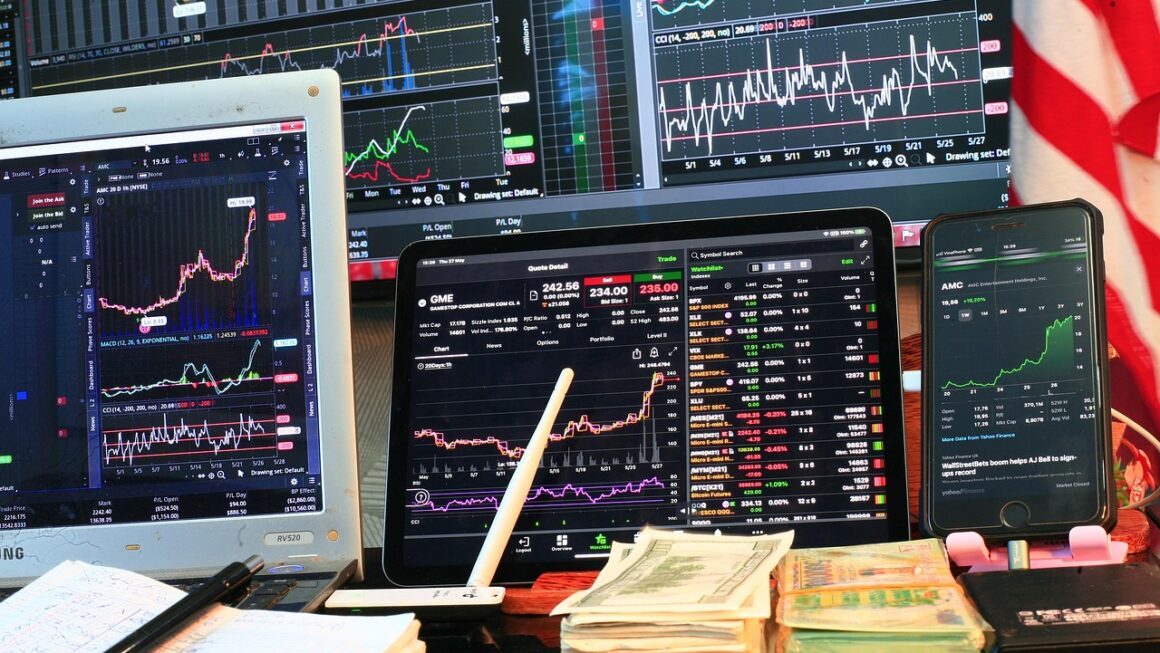Day trading: the adrenaline-fueled, high-stakes world of buying and selling financial instruments within the same trading day. It’s often portrayed as a quick path to riches, but the reality is far more complex, demanding, and risky. This article delves into the intricacies of day trading, exploring its strategies, risks, and essential considerations for those contemplating entering this challenging arena.
What is Day Trading?
Defining Day Trading
Day trading is a trading style characterized by executing multiple trades within a single day, aiming to profit from small price fluctuations. Day traders typically close all their positions before the market closes, avoiding overnight risk. The goal is to capitalize on short-term market movements using various techniques and tools.
- Involves buying and selling financial instruments within the same day.
- Aims to profit from small price movements.
- Requires active monitoring of the market and quick decision-making.
- Uses leverage to amplify potential profits (and losses).
For example, a day trader might buy 100 shares of a company like Apple (AAPL) at $170, hoping to sell them for $170.50 before the end of the day, netting a profit of $50 (minus commissions and fees).
Common Instruments Traded
Day traders participate in various markets, choosing instruments based on their volatility, liquidity, and personal preference. Some common instruments include:
- Stocks: Shares of publicly traded companies, often those with high trading volume.
- Forex (Foreign Exchange): Trading currency pairs, such as EUR/USD, benefiting from global market volatility.
- Futures: Contracts to buy or sell an asset at a future date, like crude oil or gold.
- Options: Contracts that give the buyer the right, but not the obligation, to buy or sell an asset at a specific price.
- Cryptocurrencies: Digital or virtual currencies that use cryptography for security.
Each instrument presents unique opportunities and risks. For instance, forex markets are known for their 24/5 availability and high liquidity, while cryptocurrency markets are notorious for their extreme volatility.
Essential Skills and Knowledge for Day Traders
Technical Analysis
Technical analysis is crucial for day traders. It involves analyzing past market data, primarily price and volume, to identify patterns and predict future price movements. Key components include:
- Chart Patterns: Identifying formations like head and shoulders, double tops/bottoms, and triangles.
- Technical Indicators: Using mathematical calculations based on price and volume data, such as moving averages, RSI (Relative Strength Index), and MACD (Moving Average Convergence Divergence).
- Support and Resistance Levels: Identifying price levels where the price tends to bounce or stall.
- Volume Analysis: Assessing the strength of a trend by analyzing trading volume.
For example, a day trader might use a 50-day moving average to identify potential support levels. If the price approaches the moving average and volume increases, it might signal a buying opportunity.
Risk Management
Effective risk management is paramount to long-term success in day trading. This includes:
- Stop-Loss Orders: Automatically exiting a trade when the price reaches a predetermined level, limiting potential losses.
- Position Sizing: Determining the appropriate amount of capital to allocate to each trade based on risk tolerance and account size.
- Risk-Reward Ratio: Evaluating the potential profit relative to the potential loss for each trade. A common target is a risk-reward ratio of at least 1:2 or 1:3.
- Emotional Control: Avoiding impulsive decisions driven by fear or greed.
For example, if a day trader risks 1% of their account per trade and their account size is $10,000, they would only risk $100 per trade. If their stop-loss order is set at $0.50 per share, they would buy a maximum of 200 shares.
Market Knowledge and News
Staying informed about market news and economic events is crucial for day traders. This includes:
- Economic Calendars: Monitoring key economic releases, such as GDP reports, inflation data, and employment figures.
- Company News: Staying updated on company-specific announcements, such as earnings reports, product launches, and mergers and acquisitions.
- Global Events: Monitoring geopolitical events and global news that can impact market sentiment.
For instance, a surprise announcement from the Federal Reserve regarding interest rates can cause significant market volatility, creating both opportunities and risks for day traders. Understanding the implications of such announcements is essential.
Day Trading Strategies
Scalping
Scalping involves making numerous small profits by exploiting tiny price changes throughout the day. Scalpers hold positions for very short periods, often just a few seconds or minutes.
- High frequency of trades.
- Small profit targets per trade.
- Requires fast execution and tight risk management.
Momentum Trading
Momentum trading focuses on identifying stocks or other assets that are experiencing strong price momentum in a particular direction. Traders aim to ride the wave of momentum and profit from the continued price movement.
- Identifying trending stocks or assets.
- Entering positions in the direction of the trend.
- Requires monitoring market news and volume.
Breakout Trading
Breakout trading involves identifying price levels where the price is likely to break through resistance or support levels. Traders enter positions when the price breaks through these levels, anticipating a significant price move in the direction of the breakout.
- Identifying key support and resistance levels.
- Entering positions when the price breaks through these levels.
- Requires confirmation of the breakout with volume.
Reversal Trading
Reversal trading attempts to capitalize on the end of a trend and the beginning of a new one. Traders look for signs that a price trend is weakening and enter positions in the opposite direction, anticipating a price reversal.
- Identifying weakening trends.
- Looking for divergence between price and indicators.
- Entering positions in the opposite direction of the trend.
The Risks of Day Trading
High Risk of Losses
Day trading is inherently risky, and the vast majority of day traders lose money. The high leverage, fast-paced nature, and emotional pressures can lead to significant losses. Studies have shown that a large percentage of day traders are not profitable.
- Leverage can amplify both profits and losses.
- Emotional decision-making can lead to costly mistakes.
- Market volatility can cause unexpected losses.
Time Commitment
Day trading requires a significant time commitment. Traders must dedicate several hours each day to monitoring the market, analyzing charts, and executing trades. It’s not a passive investment strategy.
- Requires constant monitoring of the market.
- Requires time for research and analysis.
- Can be emotionally and mentally demanding.
Capital Requirements
While it’s possible to start day trading with a small amount of capital, having sufficient capital is crucial for managing risk and generating meaningful profits. Many brokers have minimum account size requirements.
- Pattern Day Trader rule requires a minimum of $25,000 in a margin account for US stock day trading.
- Sufficient capital allows for diversification and risk management.
Psychological Challenges
Day trading can be psychologically challenging. The constant pressure of making quick decisions, the fear of losing money, and the emotional rollercoaster of wins and losses can take a toll on mental health.
- Stress and anxiety from constant market fluctuations.
- Emotional decision-making can lead to costly mistakes.
- Requires discipline and emotional control.
Getting Started with Day Trading
Education and Training
Before risking real money, aspiring day traders should invest in education and training. This includes:
- Reading books and articles on day trading strategies and risk management.
- Taking online courses or attending seminars.
- Following experienced traders and learning from their insights.
- Practicing with a demo account.
Choosing a Broker
Selecting the right broker is essential. Consider factors such as:
- Commissions and Fees: Look for brokers with low commissions and competitive fees.
- Trading Platform: Choose a platform with advanced charting tools, real-time data, and fast order execution.
- Customer Support: Ensure the broker provides reliable customer support in case of technical issues or account problems.
- Regulation: Verify that the broker is regulated by a reputable financial authority.
Demo Account Practice
Before risking real money, practice with a demo account. This allows you to test strategies, familiarize yourself with the trading platform, and develop your skills without financial risk. Treat the demo account as if it were real money to develop good habits and emotional control.
Conclusion
Day trading is a challenging and risky endeavor that requires a significant commitment of time, capital, and effort. While the potential for high returns exists, the vast majority of day traders lose money. Success requires a strong understanding of technical analysis, risk management, market knowledge, and emotional control. Before venturing into day trading, it’s crucial to invest in education and training, practice with a demo account, and carefully consider the risks involved. It’s not a get-rich-quick scheme, but a profession that demands discipline, dedication, and a realistic understanding of the markets.




